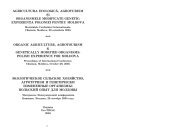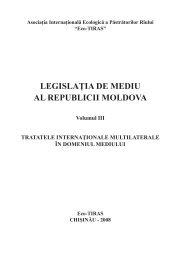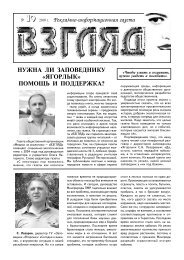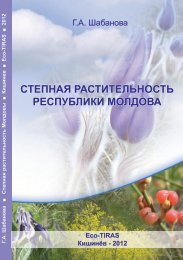Cross-cutting CriteriaThe cross-cutting criteria, such as non-discrimination,participation, accountability, impact and sustainability,also have to be considered.Non-discrimination is central to human rights.Discrimination is prohibited on grounds of race, sex, age,religion, political or other opinion, national or social origin,birth and disability. Proper public participation, meaningthe involvement of all relevant stakeholders, can help toavoid that discrimination will take place.Participation itself is one cross-cutting criterion. Allprocesses related to the planning, the design, the construction,the maintenance and the monitoring of waterand sanitation services should be participatory. This includesthe right to any information related to these issues,as well as the participation in the different decision-makingprocesses and the consideration of such when takingdecisions. It is important to include representatives of allconcerned individual, groups and communities in the participatoryprocesses.Furthermore, responsive and accountable institutionsare required for proper implementation of the right to waterand sanitation. A clear structure of responsibility andcoordination mechanisms between all different state andnon-state actors in the field of water and sanitation has tobe provided. Here again communities on all levels haveto have access to information and need to be able to participatein the decision-making processes related to theissues of water and sanitation. Furthermore, they shall bepart of the monitoring and evaluation which plays a significantrole in securing accountability. Accountability alsoincludes the right to accessible and effective judicial orother appropriate remedies in a case of violation.Impact and sustainability are the final two criteria. Goodpractices in water and sanitation have to be economically,environmentally and socially sustainable and their impactmust be continuous and long-lasting. As already laid downin the Rio Declaration sustainable solutions are best foundwith the participation of all concerned citizens.CONCLUSIONPublic participation plays a vital role for the realisationof the cross-cutting criteria. Thus, public participation isan underlying principle for the proper implementation ofthe human right to water and sanitation.This is reflected in the Protocol on Water and Healthas one of its core principles is public participation (seeArticle 5). The mechanism of setting targets and of reviewingthe same on a regular basis is an integral part ofthe principle and provides a flexible tool for the implementationof the Protocol and thus its aim to ensure, by linkingwater management and health issues, the adequate supplyof safe drinking water and adequate sanitation for all.Sensible issues, such as water and sanitation, needthe backing of the whole community. Public participationhelps to create citizens-oriented decisions and fosters livelydemocracy. However, the process is still handled verydifferently in many countries of the EECCA region. The developmentof a common understanding of what public participationmeans will deliver better results in the realisationof the human right to water and sanitation as well.Международный туристический проект«Все крепости Днестра»С.А. СухининПриднестровский государственный университет им. Т.Г. Шевченко, г. ТираспольS. SukhininThe international tourist project «All fortresses of DnIestEr»In this article the description of a route of the international tourist project is given «All fortresses of Dniester», its tourist potential comes to lightand possible ways of its realization to the separate centers of tourism on a course of its realization are defined.ВведениеПриднестровье обладает богатыми и разнообразнымирекреационными ресурсами, основу которыхсоставляет природный комплекс долины реки Днестр.Бассейн Днестра отличает разнообразие ландшафтов,обилие памятников истории и архитектуры различныхэпох и культур, что делает его привлекательнымдля туристов [8].Эффективное использование туристского потенциалаПриднестровья способно удовлетворитьпотребности в отдыхе как местного населения, таки граничащих и близких к ней регионов Молдовы,Украины, России. Однако в настоящее время туризмне играет большой роли в экономике региона [5]. Длявыхода из сложившейся ситуации главной целью деятельностив сфере туризма должно стать созданиев Приднестровье современного высокоэффективногои конкурентоспособного туристического комплекса,обеспечивающего широкие возможности для удовлетворенияпотребностей как местных, так и иностранныхграждан в разнообразных туристических услугах.В связи с этим актуальным является разработка ивнедрение на внешнем рынке международных туристическихмаршрутов, интегрирующих Приднестровьев состав туристических комплексов соседних областейУкраины (прежде всего Одесской и Винницкой) иприлежащих районов Республики Молдова [6].В связи с этим необходима разработка новоготуристического продукта, способствующего активизацииразвитию трансграничного сотрудничества настыке трех регионов и привлечению сюда туристов.В качестве такового, на наш взгляд, может выступитьмеждународный туристический проект «Все крепостиДнестра». Его программа предусматривает посещениедревних крепостей на берегу Днестра и сопредельныхместностей с целью знакомства с природой, населе-— 215 —
нием, культурой и хозяйством бассейна Днестра. Приэтом упор может быть сделан на экологических, ландшафтных,архитектурно-планировочных, историкокультурных,топонимических экскурсиях и достопримечательностях.Материалы и методыИнформационную основу для разработки данногопроекта составили непосредственные наблюденияавтора в ходе полевых исследований в регионе вовремя проведения дальних комплексных практик состудентами естественно-географического факультетаПГУ им. Т.Г. Шевченко в 2005-2010 гг., а также материалылитературных источников и интернет сайтов,касающихся главных достопримечательностей основныхцентров посещения разрабатываемого туристическогомаршрута. В связи с эти целью исследованиеявляется описание маршрута проекта, выявление еготуристического потенциала и определение возможныхпутей его реализации в отдельных центрах туризмапо ходу его осуществления.Результаты и обсуждениеИсходным пунктом для маршрута данного туристическогопроекта может быть город Белгород-Днестровский Одесской области Украины. Хотя самгород не находится на берегу Днестра, он являетсяпортом на Днестровском лимане, в 18 км от Черногоморя. Важнейшую роль в истории города играет выдающийсяпамятник средневековой фортификационнойархитектуры, наибольшее и мощнейшее сооружениеподобного типа на Украине – Аккерманская крепостьXIII-XV вв. Она была заложена на руинах греческогоантичного города Тира, на высоком скалистом берегуДнестровского лимана и возводилась около двух столетий[3]. Крепость имела 35 башен (сохранилось 20),двое внешних ворот – Главные и Овидиопольские итри внутренних. Общая длина стен около 2 км, высотадо 7 м, толщина до 5 м. Извне она окружена глубоким(до 23 м) рвом, с двух сторон ее омывает лиман.В ее составе небольшая цитадель (Генуэзский замокXII-XIII вв.) обнесенная мощными стенами с четырьмякруглыми башнями. Ныне крепость является филиаломБелгород-Днестровского музея и доступна дляознакомления. Помимо нее туристам в городе можнопосетить армянскую церковь Святой Богородицы (XV-XIX вв.), архаичную по архитектуре греческую церковьXV-XVI вв., подземную церковь Иона Сучавского XIV-XIX вв. [9].Далее туристический маршрут проекта переходитна территорию ПМР, где для туристов возможно посещениекак действующих, так и утраченных крепостей.Центральным пунктом маршрута в этой его части являетсяпосещение Бендерской крепости. Она была сооруженапо проекту турецкого зодчего Мимара КоджиСинана по образцу западноевропейских крепостейбастионного типа. Строительство началось в 1538году после вхождения города в состав Османской империи[1, 2].Сегодня современный внешний вид крепости– это земляной вал, глубокий ров, возвышающиесябашни цитадели и нижних укреплений крепости, крепостныестены, подтверждающие ее былое могущество.Цитадель – наиболее укрепленная часть крепостипостроена в форме неправильного многоугольника исостоит из восьми башен: одной многогранной, трехкруглых и четырех квадратных. Они соединены высокойстеной, достигавшей почти трехметровой толщины.В квадратной башне с центральным входомразмещалась мечеть пророка Сулеймана. Под башнямиимелись глубокие подвальные помещения. Вних хранился порох, снаряжение, продовольствие иоружие. Верхняя часть крепости была самой большойпо площади и состояла из десяти бастионов. Высотакрепостных стен верхней части и глубина рва, опоясывающегокрепость, достигали 5,3 м. Над стенамивозвышался высокий земляной вал, толщина крепостнойстены и вала достигала 14-15 м [7, 2].В верхней части крепости было трое ворот:Каушанские, Ясские и Хотинские. Наименования ихпроизошли от городов, в сторону которых они былиобращены. Через глубокий ров опускался подъемныймост. Нижняя часть крепости состояла из шести башени бастионов. В этой части крепости в основномжили пушкари, оружейники и янычары. Со стороныреки располагались массивные ворота, прозванные«водными» [7].История крепости связана со многими историческимиличностями. Так в 1709 г. после поражения подПолтавой сюда прибыли шведский король Карл XII игетман Иван Мазепа, годом позже здесь была подписана«Конституция» Ф. Орлика. В крепости служилукраинский писатель И.П. Котляревский, в ее штурмепринимали участие П.И. Панин, Е.Ф. Мейендорф, Г.А.Потемкин-Таврический, М.И.Кутузов, П.А. Румянцев-Задунайский, Е. Пугачев. С 2008 г. крепость сталаисторико-архитектурным объектом, патронируемымМВД ПМР, доступным для осмотра туристов в составеорганизованных групп.Среди утраченных крепостей на территории ПМРможно отметить польские крепости Ягорлык, Рыбница,Калаур (молд. – Кэлугэр) в с. Рашково Каменского района,но особый интерес представляет Тираспольскаякрепость. Она была заложена великим русским полководцемА.В. Суворовым 22 июня 1793 года и входилав число 58 штатных крепостей России, являясь однойиз лучших крепостей на юге России, воздвигнутой длязащиты рубежей Отечества от Турецких завоевателейв конце XVIII века.Крепость должна была иметь общий вид прямоугольника,в окончательном варианте внешнему видунеобходимо было придать правильное бастионноеочертание. Все работы в крепости в первой стадиибыли закончены концу 1795 года, она была построенапо всем правилам фортификационного искусства.На ее территории находилась церковь св. АндреяПервозванного, пороховые погреба, казармы, конюшни,цейхгаузы. В крепости мог содержаться большойвоинский гарнизон, она была оснащена современнымвооружением и обеспечена большим запасом продовольствия[4].Тираспольская крепость, как укрепленный рубежна границе России, не сыграла своей оборонной роли.По результатам Бухарестского мирного договора 1812года граница России переместилась до реки Прут иТирасполь утратил свое пограничное значение, а в1835 году крепость была упразднена. В данный моментот крепости остался лишь пороховой склад, однакодаже он представляет собой большую историческуюи культурную ценность. В перспективе здесь— 216 —
- Page 3 and 4:
Descrierea CIP a Camerei Nationale
- Page 5 and 6:
Уважаемые коллеги,
- Page 7 and 8:
щегосударственной
- Page 9 and 10:
доме, в котором мы в
- Page 11 and 12:
шие глубины на заде
- Page 13 and 14:
с малыми восстанов
- Page 15 and 16:
Литература1. Жадин
- Page 17 and 18:
Рис. 3. Многолетняя
- Page 19 and 20:
тера и глубины изме
- Page 21 and 22:
ПОДДЕРЖАНИЕ БИОРАЗ
- Page 23 and 24:
Таблица 5. Оптималь
- Page 25 and 26:
Таблица. Результат
- Page 27 and 28:
ФОРМИРОВАНИЕ БИОЦЕ
- Page 29 and 30:
Подавляющее больши
- Page 31 and 32:
Рис.1. Днестр вблизи
- Page 33 and 34:
сопоставимости дан
- Page 35 and 36:
ции с международны
- Page 37 and 38:
А.Н. Бургеля, К.П. Бу
- Page 39 and 40:
Выводы1. Уже на само
- Page 41 and 42:
тегории, виды и пор
- Page 43 and 44:
санитарно-эпидемио
- Page 45 and 46:
Таблица 4. Распреде
- Page 47 and 48:
реационных, монито
- Page 49 and 50:
Шабановой Г.А. и Кух
- Page 51 and 52:
могут быть убраны,
- Page 53 and 54:
Турунчук. Связь с с
- Page 55 and 56:
Праздник «День Рек
- Page 57 and 58:
500ЈPРис. Распределе
- Page 59 and 60:
Н. Гроссу * , Р. Шакир
- Page 61 and 62:
Рис.1. Помесячное ра
- Page 63 and 64:
Calitatea apei r. Nistru conform gr
- Page 65 and 66:
Карта геохимическо
- Page 67 and 68:
лесу был дуб, сегод
- Page 69 and 70:
При предварительно
- Page 71 and 72:
щих улучшить социа
- Page 73 and 74:
ней опасных загряз
- Page 75 and 76:
ФотоприложениеФот
- Page 77 and 78:
в Украине - одесска
- Page 79 and 80:
тия по гидрохимиче
- Page 81 and 82:
ветствующих санита
- Page 83 and 84:
ния полей, так и для
- Page 85 and 86:
В. Экономический ан
- Page 87 and 88:
Таким образом, плат
- Page 89 and 90:
Рис. 2. Динамика нор
- Page 91 and 92:
Табл. 1а. Статистиче
- Page 93 and 94:
Выводы1. Наибольшее
- Page 95 and 96:
Для днестровской в
- Page 97 and 98:
ЭКОЭТИЧЕСКОЕ ВОСПИ
- Page 99 and 100:
Таблица 1. Валовое с
- Page 101 and 102:
почвенный покров п
- Page 103 and 104:
always been the public concern of b
- Page 105 and 106:
и уникальными по си
- Page 107 and 108:
ются основными фак
- Page 109 and 110:
Рис. 4. Пораженность
- Page 111 and 112:
ight to use”. Varone et al. (2002
- Page 113 and 114:
mass media, etc., which belong to d
- Page 115 and 116:
В связи с тем, что К
- Page 117 and 118:
период поездки вых
- Page 119 and 120:
doutchinae (d’Orb.), выше з
- Page 121 and 122:
вместе с осадками в
- Page 123 and 124:
Таблица 4. Содержан
- Page 125 and 126:
efectuat în baza următorilor indi
- Page 127 and 128:
видуальных различи
- Page 129 and 130:
- соответствующее з
- Page 131 and 132:
ФАУНА КЛЕЩЕЙ ДРЕВЕ
- Page 133 and 134:
Таблица 1. Данные ра
- Page 135 and 136:
РЕКРЕАЦИОННЫЕ РЕСУ
- Page 137 and 138:
ЭТАПЫ ЭВОЛЮЦИИ БИО
- Page 139 and 140:
Плотина Дубоссарск
- Page 141 and 142:
чимые. При этом «пе
- Page 143 and 144:
Схематически получ
- Page 145 and 146:
Таблица 5. Данные на
- Page 147 and 148:
Risks for biodiversity with tested
- Page 149 and 150:
14. Ярошенко M.Ф., Дед
- Page 151 and 152:
20082009Fig. 2. Structure of shrew
- Page 153 and 154:
с природой (различн
- Page 155 and 156:
делить в их предела
- Page 157 and 158:
Таблица. Оценка эне
- Page 159 and 160:
лах Приднестровья
- Page 161 and 162:
ВыводыКраеведческ
- Page 163 and 164:
вий среды жизнедея
- Page 165 and 166: Senecio besserianus Minder. Cypripe
- Page 167 and 168: Рис.1. Почвенная кар
- Page 169 and 170: половины площади п
- Page 171 and 172: Рис. 2. Современное
- Page 173 and 174: ПРИЧИНЫ ГЕОМОРФОЛО
- Page 175 and 176: RÂURILE MICI CU ŞANSE MARIDE A FI
- Page 177 and 178: ЭКОНОМИКО-ЭКОЛОГИЧ
- Page 179 and 180: прибрежной зоной (п
- Page 181 and 182: Строительство в пр
- Page 183 and 184: государственного у
- Page 185 and 186: ческий, социальный
- Page 187 and 188: ми, послужило весом
- Page 189 and 190: губительно влияющи
- Page 191 and 192: ных за контролем и
- Page 193 and 194: PECULARITIES OF DYNAMICS OF PHOSPHO
- Page 195 and 196: Fig. 4. Spatial and seasonal dynami
- Page 197 and 198: • inventory of point discharges s
- Page 199 and 200: СТЕРИЛИЗАЦИЯ КАК С
- Page 201 and 202: гормоны (в незначит
- Page 203 and 204: ПРОТОКОЛ ПО ПРОБЛЕ
- Page 205 and 206: воды ежегодно умир
- Page 207 and 208: РАЗРАБОТКА ПЛАНОВ
- Page 209 and 210: ставляет материаль
- Page 211 and 212: • Совершенствован
- Page 213 and 214: «Алые паруса». Таки
- Page 215: which the Committee is then require
- Page 219 and 220: - Николаевская церк
- Page 221 and 222: Сброшенный на 50 м б
- Page 223 and 224: СТРУКТУРА ГЕОИНФОР
- Page 225 and 226: 4. Пространственная
- Page 227 and 228: На фазе пика числен
- Page 229 and 230: А.А. Тищенков, В.В. М
- Page 231 and 232: Распределение видо
- Page 233 and 234: цветковый (ККП, ЧКУ,
- Page 235 and 236: очередной задачей
- Page 237 and 238: схемой планировани
- Page 239 and 240: эксплуатационным п
- Page 241 and 242: ных дамб, с возвращ
- Page 243 and 244: ледствия от урбани
- Page 245 and 246: ОСНОВНЫЕ ФОРМЫ ДЕГ
- Page 247 and 248: УЧАСТИЕ НЕПРАВИТЕЛ
- Page 249 and 250: струкции как от сбр
- Page 251 and 252: Рогоз широколистны
- Page 253 and 254: Таблица 3. Изменени
- Page 255 and 256: В рамках первых тре
- Page 257 and 258: Основные экскурсио
- Page 259 and 260: 2. Кравченко Е.Н. При
- Page 261 and 262: Decision-Maker user group are respo
- Page 263 and 264: может ее запускать,
- Page 265 and 266: поражения населени
- Page 267 and 268:
тию РДЮЦ «ГУТТА - кл
- Page 269 and 270:
мость разработки н
- Page 271 and 272:
Биология. Подорожн
- Page 273 and 274:
банизированных тер
- Page 275 and 276:
Результаты исследо
- Page 277 and 278:
площадь ассимиляци
- Page 279 and 280:
Рис. 3. Дендрограмма
- Page 281 and 282:
Рис.1. Сезонная дина
- Page 283 and 284:
Молдовы и Приднест
- Page 285 and 286:
Ребята приехали в 10
- Page 287 and 288:
Рис. 1. Численность
- Page 289 and 290:
жений, в том числе э
- Page 291 and 292:
[4]. Несомненно, выжи
- Page 293 and 294:
КОНСТИТУЦИОНАЛЬНА
- Page 295 and 296:
В настоящее время б
- Page 297 and 298:
8. Суворцева В.Ю., Ру
- Page 299 and 300:
Окончание табл. 2Ок
- Page 301 and 302:
содержаниеПРЕДИСЛ
- Page 303 and 304:
А.П. Погребняк, В.Ф.
- Page 305:
Научное изданиеБАС


![[download]13,2 Mb - Eco - Tiras](https://img.yumpu.com/50284532/216/500x640/download132-mb-eco-tiras.jpg)













